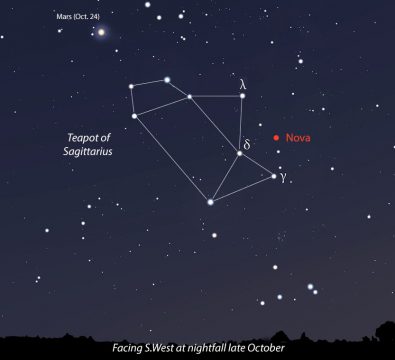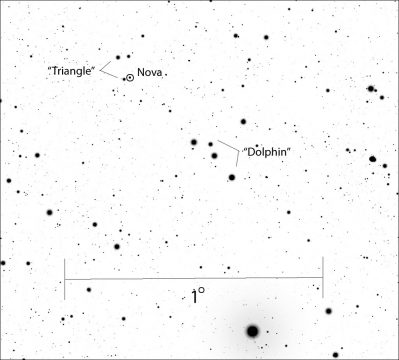Astronomy - 8th-magnitude Nova in Sagittarius
A nova in Sagittarius, discovered a few nights ago by a Japanese amateur, has become bright enough to see in binoculars.
| Update: As of October 31st, the nova had been holding at about magnitude 8.0 for a week. It's temporarily designatedTCP J18102829-2729590.
This is not to be confused with another nova just above the spout of the Sagittarius Teapot! The new one, temporarily named ASASSN-16ma, was discovered five days later on October 25th. As of October 31st it was about magnitude 9.7 and perhaps still rising. Expect an article by Bob King shortly.
|

This map shows the sky facing southwest in late twilight for observers across the central U.S. and southern Europe. The 8th-magnitude nova (exaggerated here!) lies just above the spout of the Sagittarius Teapot, at right ascension 18h 10m 28s, declination –27° 29′ 59″. It has been temporarily dubbed TCP J18102829-2729590 accordingly.
Stellarium
Stellarium
Just in the nick for time — at least for northern observers — a bright nova has been discovered in Sagittarius. I say "nick of time" because the constellation is sinking in the southwestern sky right after dusk, affording only a short viewing window from mid-northern latitudes. But a window it is, and there's still time to snatch a view of this amazing stellar explosion. Just make sure to look right after the end of twilight. That means about an hour and a half after your local sunset time.

I've labeled the two bright 'spout stars' in this more detailed map, which shows stars to about magnitude 9.5. This will get you very close. To continue to the nova, use the more detailed chart below.
Stellarium
Stellarium
Well-known nova hunter Koichi Itagaki of Japan nabbed the "new star" on October 20th, using a 180-mm telephoto lens to take sky-patrol photos. At the time it was only about 11th magnitude. But within two days, the star shot up an additional three magnitudes and now shines brighter than 8.0. That puts it within range of 50-mm binoculars and any telescope you might have.

Use this final chart, which shows stars to about magnitude 10.5, to arrive at the nova. I've labeled a couple suggestive asterisms you can look for that will help you get there. North is up.
Stellarium
Stellarium
Get out early for the best views. First, locate Sagittarius in the southwestern sky using Mars as your guide. Then focus on the two stars at the end of the spout and use the maps above to track your way through a dense Milky Way field to pinpoint the nova. Work step by step; it may take some time. It is Sagittarius after all, a constellation known for its stellar throngs.

Novae occur in close binary systems where one star is a tiny but extremely compact white dwarf star. The dwarf pulls material into a disk around itself, some of which is funneled to the surface and ignites in a nova explosion.
NASA
NASA
All classical novae are close binary stars with a compact white dwarf stealing hydrogen from its companion. The gas ultimately funnels down to the surface of the dwarf, where its piles up on the star’s surface. It becomes compacted by gravity and heated until hydrogen fusion ignites. The layer explodes like a hydrogen bomb in the shape a thin shell enclosing the star. This is what you see when you look at a nova – a gigantic bomb going off! The underlying white dwarf survives intact, and begins accreting a new, fresh layer that will eventually explode again.
Material gets blasted into space at tremendous speeds of some 3,000 kilometers per second (6.2 million mph). A faint, unnoticed star brightens 50,000 to 100,000 times in a matter of hours, becoming luminous enough for someone back here on Earth to spot it in binoculars over the trees. Simply remarkable.
You can keep track of what the nova's doing night to night by visiting the American Association of Variable Star Observers (AAVSO) website and entering its temporary name, TCP J18102829-2729590, in the Pick a Star box. You then have options to check recent observations, plot a light curve of them, or create a chart of your own. More details, including recent magnitude estimates, can be found in the AAVSO's Alert Notice for the nova. Click hereto download an AAVSO chart with magnitudes, so you can track the star's changing brightness.
No comments:
Post a Comment